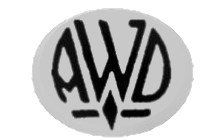

The marque's name is derived from the initials and location of the manufacturer - August Wurring, Dusseldorf.
Initially a bicycle repairer, Wurring's interest in motorcycles led him to begin building motorised bicycles, and full-sized machines soon followed. Always a specialist, production was limited but quality was high. In a time when frame breakages were not uncommon, he offered a lifelong guarantee on the AWD frames.
A.W.D. built frames for racing motorcycles, and complete motorcycles with 123cc to 499cc DKW, Kühne, Küchen, JAP, Blackburne, Villiers, ILO, and Sachs engines.
Post-war, mopeds were produced between 1955 and 1962, and they built limited numbers of sports machines using twin-cylinder 250cc JLO engines, continuing activities until 1979 when production of the JLO engine had long ceased. It is postulated that they either had NOS engines, or rejuvenated old ones.
During this period the firm's focus shifted to the production of emergency services vehicles and agricultural equipment.
Mopeds
Competition
Wurring was a keen racer and appeared in many events throughout Germany in the 1920s and early '30s, but gave it away during the Nazi era as a requirement for competition was to gain membership of a National Socialist organisation, something he was loathe to do.
After war's end he became a sidecar racer, and did well. The firm built all manner of competition machines in this period - cement track racers (Zementbahnrennen, a specialty), early scramblers and off-road machines, and of course road-racers.
The track record at Bielfeld of 122.5 km/h was set by Erwin Alldinger on an AWD in 1953.
Sources: Hartmut Schouwer, awdmuseum.de